 ...magazines
tore funny cars apart, showed you what they were made of and what
they cost? In the late 60s, SS&DI broke down one of the Jungle
Jim Novas, in the early 70s Car Craft dismantled the Whipple &
McCulloch Duster (total investment was approx $49,000 including
tow car, trailer, spare motor, insurance, etc). In 1978 Car Craft
magazine dissected the War Eagle Firebird of Dale Pulde ("55
Easy Pieces, June 78) but didn't discuss the costs involved. In
the new millennium, just like in the late 70s, if you have to
ask, you can't afford it. (Photo from cover of Car Craft magazine,
March 72)
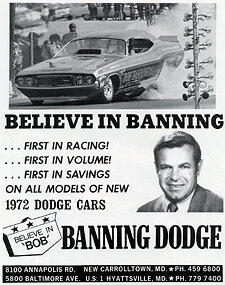
...there
was a time local car dealers like Bob Banning Dodge, Beach City
Chevrolet, Mr. Norm, Doran Chevrolet, Tasca Ford, etc., could actually
afford to sponsor a nationally recognized funny car in order to
get the dealership's name in front of potential customers? Even
small speed shops like Goodies, Steve Kanuika, Honest Charlie,
Wise, K&G Speed Associates, etc., could get in on the act!
(Ad from 73 Aquasco Yearbook)

...magazines
had the "inside scuttlebutt" and "hot rumors"
on F/C goings on... and off track? SS&DI had "Agent
1320" which later became "1320 Notes", Hot Rod
had "Rodding at Random", Car Craft had "Straight
Scoop", etc. Among the "teasers" that never saw
light were Jake Johnston fielding a Burger King sponsored Pinto
wagon (73), Tom McEwen retiring unless the seriously considered
multi-sanctioning body nitro ban took effect in 75 (74), underage
Billy Meyer signing multi-contract with Lone Star Beer (75), Don
Prudhomme possibly signing a deal with Ford and campaigning a
Mustang II flopper (76), Jerry Boldenow switching the Moby Dick
Vette F/C to a Monza body to overcome the Corvette jinx (77),
Johnny Loper going with a two car team by adding a T/F effort
(78), etc, etc, etc. Above rumors shall remain unattributed...
 ...in
the mid-70s there was a movement to change the long held term
"funny cars" to "fuel coupes"? Hot Rod magazine
was one of the proponents... and some teams joined in the move,
showing up with the driver's # and "AA/Fuel Coupe" etched
on the car instead of the old "AA/FC" identifier. (Photo/info
from July 76 Hot Rod magazine, used with permission.)
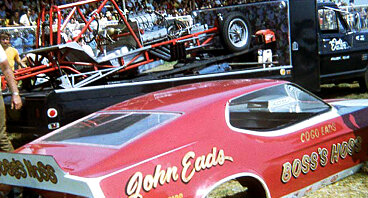 ...funny
cars spit out rear ends like watermelon seeds? Some of the heaviest
hitters in the business fell pray to the problem in the 71 timeframe... list
included the Ramchargers, Hawaiian, MT Pinto, Whipple & McCulloch,
Fred Goeske, Bergler & Prock, Tom Hoover, etc. Reports indicated
the problem was related to improved tire compounds coupled with
weak rear end mounts that put an inordinate priority on saving
weight! Pictured is John & Cogo Eads' Boss's Hoss Mustang
after suffering the same fate at Corpus Christi. (Photo courtesy
of Rick Lewis)
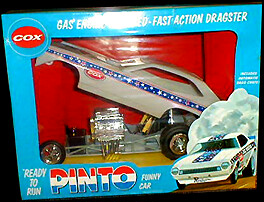 ...if
you couldn't afford a "real" funny car Cox could set
you up with one? The 1/12 scale replica of Bill Schifsky's MN
based, Cox sponsored Pinto nitro flopper was on store shelves
in 1972... car was powered by a049 displacement engine, ran
down a guide line where the engine shutoff and the chute automatically
deployed. Cost was $19... 1/12 scale yellow "no name"
version of the "not to successful in real life" Vega
Panel Wagon F/C was introduced by Cox in 73. (Photo courtesy of
Harold Elliott)
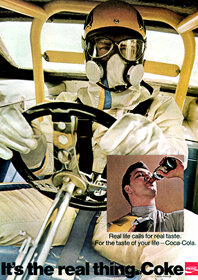  ...in the days before the "beer
wars" when Coca-Cola was heavily involved in drag racing?
From the 70s Coke Cavalcade of Stars F/C circuit that brought
funny cars shows to some of the nation's smaller venues, to those
great ads Coke ran featuring such stars as SWC, Kelly Chadwick,
Mickey Thompson, etc., to those funky red and white checkered
pants that Coke teams wore, to the scoreboards at many tracks
emblazoned with the Coke emblem, Coke was a major drag racing
force in the early 70s! (Photo at left from Coke ad; right photo
from John Bergener)
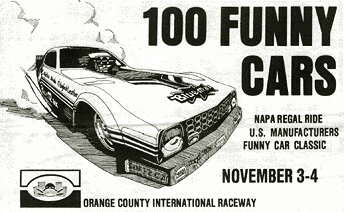 ...
100 funny cars could actually show up to an event? Or further
more, how about when 100 funny cars even existed! Remember when
the grand daddy of all flopper events was the Manufacturers Meet
held each fall at OCIR. From 68-74 race utilized four 8 car teams
made up of different manufacturers (Chevy, Ford, Dodge, Plymouth)
that ran 3 full rounds, team vs. team with the 2 low et cars coming
back for the final. 1973 version of the race was under AHRA sanction
and arguably the beginning of the end. Gone were the marching
bands, fireworks, pre-race line-up and driver introductions (some
of which later returned under Steve Evans), etc. More importantly,
after qualifying in 8 car teams by manufacturer type and running
the first round team vs. team, gone was the remaining two rounds
of team vs. team competition. After Round 1, subsequent pairings
where determined solely on winning et from the previous round.
In 74 race returned to it's pre-73 format (team vs. team for 3
rounds) but by 75 event didn't use the manufacturers body style
qualifying format but qualified the 32 positions based strictly
on elapsed times with a standard 32 car elimination format. (Ad
from 78 OCIR Manufacturers Classic)
 ...new
or rebuilt funny cars would sometimes show up still in primer... or
in no primer at all... and shoe polish made great "lettering"?
Pictured is the Kirby Bros newly constructed Chevy powered SoCal
Camaro from 1970. (Photo courtesy of Drag Racing Memories)
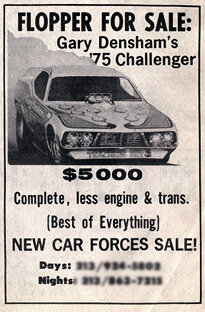 ...funny
car racing didn't seem as expensive as it does today? As a point
of comparison, $5000 dollars in 1975 is equivalent to about $15,500
in year 2000 dollars. By the way, car was sold to So Cal alky
flopper racer Dale Van Gundy. (Ad from Feb 76 issue of Drag News)
 ...fire
burnouts were all the rage in the early 70s? Pictured is the Texas
based Brand-X Mustang... however the Chevy guys including Dick
Harrell, Bruce Larson, David Ray wheeling the Steakley Camaro
and Jungle Jim were generally acknowledged as the "kings"
of the fire burnouts! (Photo from Brand-X handout courtesy of
Jim White)
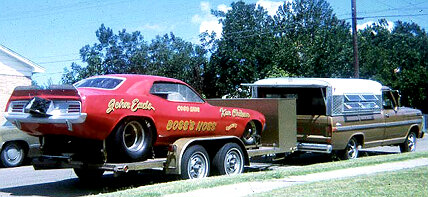 ...open
trailers were state of the art transportation for floppers.
 ...more
than one funny car World Championship title was contested?
AHRA Grand American series champs in the 70s were: 70, 71-Gene
Snow, 72-Leroy Goldstein, 73-Don Schumacher, 74-Don Prudhomme,
75-Tom McEwen, 76, 77-Tom Hoover, 78-Gene Snow, 79-Tom McEwen.
In the late 60s, AHRA was the first sanctioning body to give
recognition to funny cars, went on to use the controversial practice
of "seeding" flopper fields in the early 70s by booking
in 8 cars for their 16 car nitro programs, leaving only 8 slots
open for qualifying. (AHRA decal from the Attic Collection)
 ...funny
cars had names, showed up to the races on open ramp trucks, and
used tow cars often supplied by spectators after the crowd was
pulsed by the track announcer for "volunteers"? (Photo
by Franko of Malcolm Durham's "Strip Blazer," Warner
Robins, GA., circa 71/72)
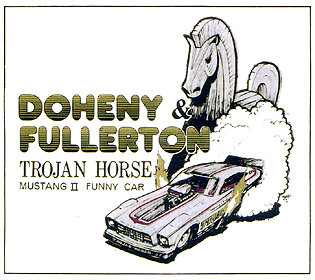
...flopper
teams had cool decals as well as handouts? Very few teams did,
but one of those few was Doheny & Fullerton who had this Youngblood
rendering of the Trojan Horse. According to Kenny Youngblood,
he did a lot of art work for the team, from paintings to press
kits. When it came time to be paid... "Kevin [Doheny] tells
me to bring the bill down to his "office" in L.A... which
turns out to be this 25 story skyscraper! Sure enough, way up
on top it said "DOHENY BLDG." Kevin was the Grandson
of the oil rich Doheny family (the "Rothschild's" of L.A.)
that they named "Doheny Beach" and "Doheny Blvd"
after. So I stroll up to the 17th floor, and presented the bill
to a room full of stuffy old bastards that grumbled about Kevin
"squandering the family fortune on a funny car". (Decal
courtesy of David Hapgood, story courtesy of Kenny Youngblood.)
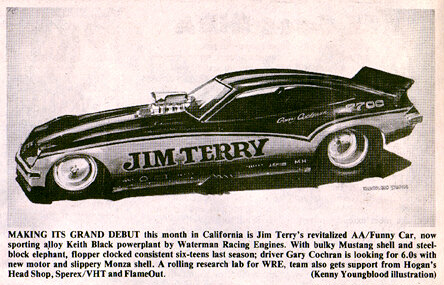
..."Season
Preview" issues of drag racing periodicals gave salivating
insights into the coming season's crop of new nitro floppers well
before they hit the asphalt? Pictured is Jim Terry's SoCal based
Skylark (even though the illustration says Monza, it was run as
a Buick) from the March 13, 1976 issue of Drag News. (Illustration
by Kenny Youngblood, used with permission of Youngblood Motorsports
Gallery; see our Links Page)
 ...magazines
ran drag races. Super Stock & Drag Illustrated, Cars magazine,
Popular Hot Rodding, Hot Rod and even National Dragster hosted
events in the 60s and 70s? Pictured is Bruce Larson's USA-1
on the program cover from the 1970 SS&DI Nationals at York
US 30. Flopper show at the event was won by Larry Reyes and the
Hawaiian
on Saturday,
Candies and Hughes won Sunday and the overall event title. (Cover courtesy of the Bob Plumer Collection.)
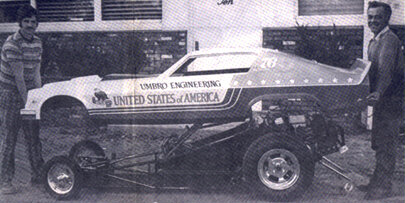
...in
the mid-70s Umbro Machine & Tool from NY tried to introduce
mini Vega funny cars? The UMT sales brochure claimed "The
nitro burning funny cars... were always the deepest dream of the
drag racer. Due to the vast amounts of work, design, and the money
involved, the majority of drag racers could do nothing else but
dream. With all this in mind, the Engineers and craftsmen at UMT
combined their skills and brought about the birth of this exciting
mini FUNNY CAR. WHEELIES - BURNOUTS - and FIRE belching headers along
with a sling shot takeoff from the starting line is getting a
tremendous response from crowds of racing fans all over the country
and is becoming the wildest new trend in drag racing history."
Based on a Vega body, the sales brochure claimed a weight of 500
lbs on a 75 1/2" chassis. Body color was optional, as was
choice of engines. Car could be bought complete or as blueprints.
Car even came with a parachute! (From Umbro Sales Brochure, courtesy
of the Greenberg Collection)
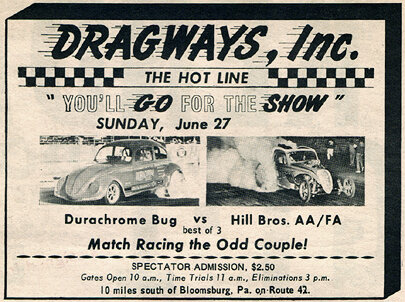 ...funny
cars ran against fuel altereds, fuel dragsters, jet cars, etc?
Tracks hosted Ford vs. Chevy flopper shows, Women's Lib shows featuring
Della Woods, Paula Murphy, etc., against the men, "Mr. King
of the Hill" F/C shows, 32 car blown nitro extravaganzas,
mid-week F/C shows, etc, etc, etc, all during the good-ole-days
of funny car racing in the early to mid 70s. (Match race ad from
June 25, 1971 issue of Drag Times, courtesy of the Attic Collection.)
 ...magazines
ran great color "Photos For Framing" that use to find
their way out of the magazines and onto the walls of bedrooms,
shops, school lockers, etc? (Photo from Super Stock and Funny
Car Magazine/Jan 71-Courtesy of the Greenberg Collection, photographer
unknown.)
 ...Revell
made great models AND seemed to sponsor all the "heavy hitters"? Revell's 1975 flopper lineup included Jungle Jim,
Phil Castronovo, Chuck Tanko, Joe Mundet, Willie Borsch, the Chi-Town
Hustler, Don Schumacher, Gene Snow, Mickey Thompson, Pisano & Matsubara, Ed McCulloch, Tom McEwen and the Snake. According to
a knowledgeable source, the Revell "deal" that Jungle
(and others) had was: 1 new body, with paint & lettering per year... not quite the high $$$$ deal it seemed! However, in 76
Revell did pay its sponsored floppers contingency money based
on their performance in open competition. (Model box side panel
courtesy of the Greenberg Collection)
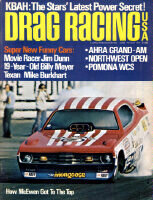  ...drag racing magazines flourished
on newsstands in the early 70s, but by the mid to late 70s most
had disappeared? One of the most popular was Drag Racing USA which
was primarily devoted to the West Coast drag racing scene. Pictured
is the cover of the August 74 issue. DRUSA ceased publication
in June 1975. At right, Super Stock and Funny
Car magazine was published bi-monthly on the East Coast and concentrated
on the East Coast nitro and F/C scene. Pictured is the cover of
the November 71 issue featuring Gene Conway's Corvette... sister
publication in off-months was Rodder and Super Stock. (From the
Attic Collection)
 ...local
tracks ran nitro shows? Ad from August 4, 1972 issue of Drag
Times. (From the Attic Collection)
 ...one of the best sources for weekly information
about F/C goings on was the west coast publication Drag News?
Covering ALL sanctioning bodies and both coasts, DN started publication
in the mid-50's and ran through approximately 1978. Pictured is
the February 1, 1975 cover featuring the Pisano and Matsubara
Vega which won OCIR's 8th Annual Season Opener over Jake Johnston
in the Keeling and Clayton Mustang at 6.67/200. (Courtesy of the
Greenberg Collection)
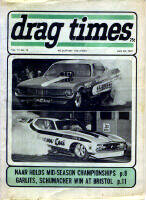 ...for
east coast drag racing results, Virginia based Drag Times was
the source? Covering some of the smaller venues (Elk Creek Dragway,
Summer Duck Dragway, etc) and east coast circuits, "Jack
Approved" (JA) stickers from DT adorned many nitro cars of
the era. Pictured is the June 23, 1972 cover featuring one of
Don Schumacher's Cudas and the Swenson & Lani Mustang from
New Jersey. (From the Attic Collection)
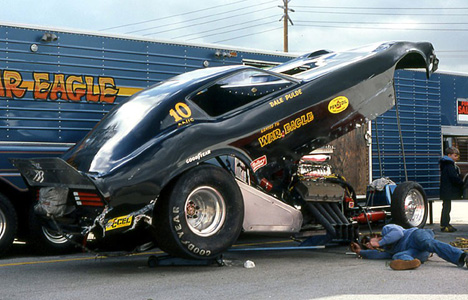
...funny cars did not have spare bodies? Before carbon fiber and Kevlar
bodies came, you could repair your funny car body over and over. They
had to tape, epoxy, or primer the damaged areas to keep racing. The
body usually had to last all year and beyond. Dale Pulde's "War
Eagle" Firebird shows the scars of a minor accident. (Info by Danny
White; photo by Mike Ditty)

... You could follow
your favorite funny car racer in local divisional standings! That
practice ended after the 1980 season in the NHRA. (National Dragster
scan courtesy of Phil Burgess)
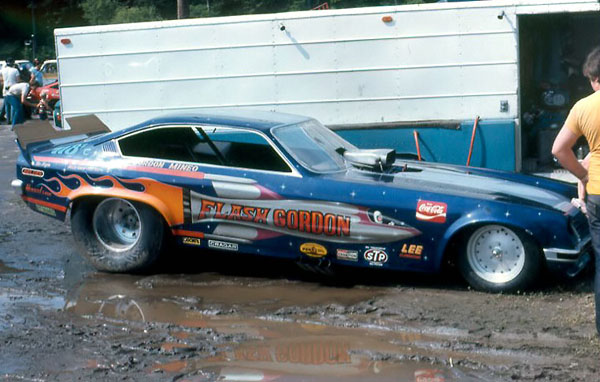
... in the match races days, Pro racers had to take what was given?
Sometimes that meant parking the car in muddy pits. Here's
"Flash" Gordon Mineo in the pits at Lebanon Valley prior
to the race. These are some of the good ol' days the Pros just
might want to forget! (Text by Danny White; photo by Kevin at
Ultragraphic Decals)
[ Back ] [ Home ] [ Next ]
|
